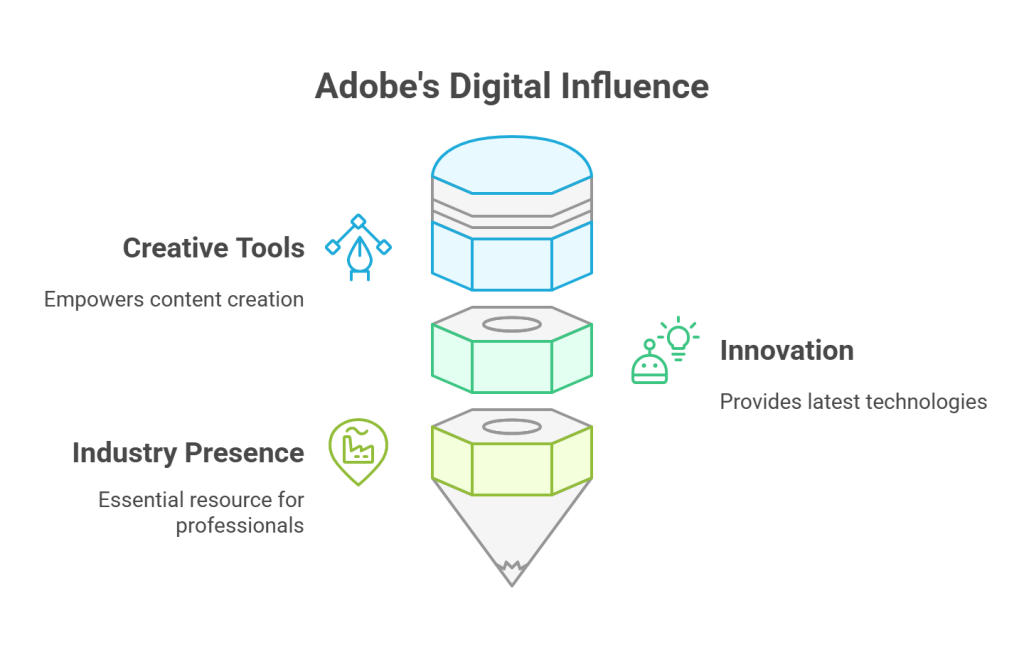Have you ever wondered what powers the stunning visuals, engaging videos, and interactive experiences you encounter online every day? In today’s dynamic digital era, where content is king and visual communication reigns supreme, the demand for high-quality digital assets is insatiable.
From the captivating advertisements scrolling through your social media feed to the intuitive interfaces of your favorite apps, a powerful suite of tools underpins this creative explosion.

This article will demonstrate that Adobe’s suite of creative tools is not just a collection of software, but a fundamental pillar supporting and driving innovation across virtually every aspect of the digital world.
The Industry Standard for Creative Professionals
At the heart of any professional digital endeavor, you’ll find Adobe User List applications. For decades, these tools have been the undisputed gold standard in creative industries.
Take Photoshop, for instance; it remains the most dominant creative software with a substantial 34% market share, a testament to its unparalleled capabilities in image editing.
When it comes to vector graphics and building powerful brand identities, Illustrator is the go-to choice, with Adobe products commanding over 80% of the graphic design software market overall.
And for those crafting compelling narratives through moving pictures, Premiere Pro and After Effects are the workhorses for video editing and motion graphics. It’s no surprise that a quick glance at job postings for designers, marketers, and multimedia specialists reveals that proficiency in Adobe Creative Cloud is often a core requirement.
Comprehensive Ecosystem and Seamless Workflow (Creative Cloud)
One of Adobe’s most significant strengths lies not just in individual applications, but in its integrated Creative Cloud ecosystem. This unified platform fosters seamless collaboration and incredibly efficient workflows.
The Creative Cloud operates on a subscription model, providing access to a vast array of creative software that are designed to work together harmoniously. Imagine designing stunning visuals in Photoshop or Illustrator, then effortlessly linking those files into InDesign for a print layout, or importing Premiere Pro sequences directly into After Effects for advanced visual effects.
This interoperability is a game-changer. Furthermore, cloud storage and synchronization benefits mean that creative teams, whether across town or across continents, can access, share, and collaborate on projects with unprecedented ease.
This interconnectedness is a key driver of productivity, as exemplified by how a typical digital marketing campaign might flow: visuals are designed in Photoshop/Illustrator, ad layouts are created in InDesign, promotional videos are edited in Premiere Pro, and all assets are readily accessible and shareable via Creative Cloud Libraries.
The continued growth of Creative Cloud is evident, with subscriber accounts estimated to reach 37 million in 2024, demonstrating its widespread adoption.
Powering Digital Marketing and Communication
In the digital era, effective digital marketing and persuasive visual communication are paramount, and Adobe tools are indispensable for both. Businesses rely heavily on applications like Photoshop, Illustrator, and Adobe Express to create eye-catching social media graphics, impactful website banners, and professional email templates.
The versatility extends to document management, with Acrobat playing a crucial role in crafting well-designed PDFs for reports, presentations, and e-books. Beyond static content, the power of video is undeniable in modern marketo users list.
Research shows that visual content is 40 times more likely to be shared on social media, underscoring the critical role of tools like Premiere Pro and After Effects in producing engaging video content.
Companies regularly leverage Adobe to establish strong brand identities and maintain consistent marketing materials across diverse platforms, with examples like Deloitte Digital reimagining its global brand identity using Adobe Firefly highlighting the suite’s impact on major brands.
Enabling Innovation in Web Design and Interactive Experiences
The demand for intuitive and visually appealing online experiences has never been higher, and Adobe continues to be a cornerstone for web design and interactive content creation.
Adobe XD has emerged as a powerful tool for UI/UX design and prototyping, allowing designers to create interactive mockups and user flows that simulate the actual user experience before a single line of code is written. Beyond XD, Photoshop and Illustrator remain essential for crafting all the intricate web assets and graphics that bring websites to life.
Whether it’s the sleek interface of a new social media app, the seamless navigation of an e-commerce store with detailed product listings, or the engaging user journey of an e-learning platform with interactive quizzes, Adobe tools are at the forefront of creating these digital interactions.
Adaptability and Future-Proofing for the Digital Age
Perhaps one of the most compelling reasons for Adobe’s continued cruciality in the digital era is its unwavering commitment to adaptability and future-proofing through the integration of cutting-edge technologies.
Adobe consistently evolves its products to meet the demands of emerging trends, particularly through the strategic incorporation of artificial intelligence (AI).
Features like Photoshop’s Generative Fill and Generative Expand empower users to seamlessly add, remove, or expand content within images with remarkable realism, while Illustrator’s Text to Vector Graphic and Generative Recolor allow for rapid ideation and manipulation of vector artwork.
The Adobe Firefly generative AI models are being integrated across the Creative Cloud, enabling creators to generate images and even videos from simple text prompts, revolutionizing the creative process. Furthermore, the availability of Adobe Firefly as a mobile app, alongside tools like Photoshop Express and Rush, means that creativity is no longer tethered to a desktop.
This continuous innovation, coupled with regular software updates, ensures that Adobe remains at the forefront, shaping the future of digital creativity and empowering users to stay ahead in an ever-evolving landscape.
Final Thoughts
In sum, Adobe’s enduring presence and continuous innovation underscore its indispensable role in the modern digital era. From setting the industry standard for creative professionals to fostering seamless workflows through its comprehensive Creative Cloud ecosystem,
Adobe is the engine driving high-quality digital design and content creation. Its tools are fundamental to effective digital marketing and communication, enabling businesses to captivate audiences, and they are at the forefront of innovation in web design and interactive experiences.
Most importantly, Adobe’s commitment to integrating advanced AI capabilities ensures its products remain adaptable and future-proof, empowering creators to push boundaries.
In an increasingly visual and digital world, mastering Adobe tools isn’t just an advantage – it’s a necessity. Take the first step today and unlock your creative potential with Adobe by exploring their Creative Cloud offerings or diving into a free trial of a key application like Photoshop or Premiere Pro. The future of digital creativity is here, and Adobe continues to lead the way.


